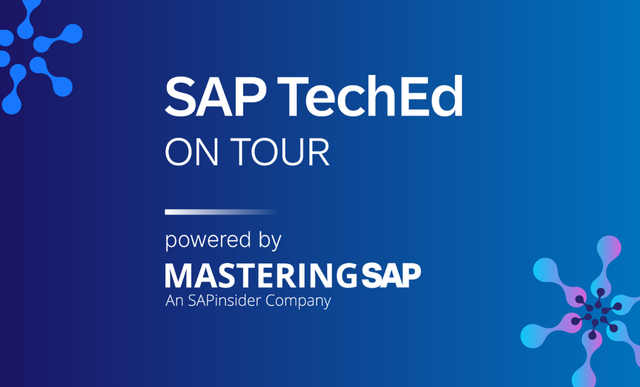Retail and eCommerce
Filter By
Browse By
- SAP Analytics and AI
- SAP Application Development and Integration
- All SAP Application Development and Integration
- SAP ABAP
- SAP ABAP Development Tools
- SAP ABAP Test Cockpit
- SAP API Management
- SAP BAPI
- SAP Basis
- SAP BRF
- SAP Business Application Studio
- SAP CMS
- SAP Design Studio
- SAP Development Tools
- SAP DevOps
- SAP EAI
- SAP EDI
- SAP Extension Suite
- SAP Fiori
- SAP Fiori Elements
- SAP Integration Suite
- SAP Low Code Application Development
- SAP Low Code Automation
- SAP Netweaver
- SAP Release Management
- SAP UI5
- SAP Web Application Server
- SAP Web IDE
- SAP Business Process Management
- SAP Center of Excellence
- SAP CIO
- SAP Customer Experience
- SAP Data and Data Management
- All SAP Data and Data Management
- SAP BW
- SAP BW/4HANA
- SAP Crystal Reporting
- SAP Data Archiving
- SAP Data Center
- SAP Data Governance
- SAP Data Integration
- SAP Data Migration
- SAP Data Quality
- SAP Data Services
- SAP Data Strategy
- SAP Data Visualization
- SAP Data Warehouse Cloud
- SAP DMS
- SAP Document Control
- SAP EIM
- SAP ETL
- SAP ETL Tools
- SAP HANA
- SAP HANA Administration
- SAP HANA Deployment Infrastructure
- SAP HANA Studio
- SAP Master Data
- SAP Master Data Governance
- SAP MDM
- SAP Enterprise Architect
- SAP Enterprise Asset Management
- SAP ERP
- SAP Finance
- All SAP Finance
- SAP Accounting
- SAP AR AP
- SAP Asset Accounting
- SAP Billing Systems
- SAP BPC
- SAP BRIM
- SAP Cash Management
- SAP Central Finance
- SAP Controlling
- SAP COPA
- SAP Cost Center Accounting
- SAP e-invoicing
- SAP FICO
- SAP Finance Automation
- SAP Financial Closing Cockpit
- SAP Financial Consolidation
- SAP Financial Planning
- SAP FX Risk
- SAP General Ledger
- SAP Global Tax Management
- SAP Hyperion
- SAP Order to Cash
- SAP Payment Processing
- SAP Profitability Analysis
- SAP Rebate Management
- SAP S/4HANA Finance
- SAP Universal Journal
- SAP Governance Risk and Compliance
- SAP Human Capital Management
- SAP Intelligent Technologies
- SAP Platform and Technology
- All SAP Platform and Technology
- SAP Business Technology Platform
- SAP Cloud Connector
- SAP Cloud Integration Platform
- SAP Cloud Migration
- SAP Cloud Platform
- SAP Cloud Providers
- SAP Cloud Strategy
- SAP Container Platform
- SAP Digital Asset Management
- SAP Digital Integration Hub
- SAP Digital Signature
- SAP HANA Enterprise Cloud
- SAP HEC
- SAP Hyperscalers
- SAP Infrastructure
- SAP Messaging
- SAP Smart Forms
- SAP Quality and Testing
- SAP Security
- SAP Spend Management
- SAP Supply Chain Management
- All SAP Supply Chain Management
- SAP APO
- SAP Asset Management
- SAP Business Network
- SAP Digital Manufacturing Cloud
- SAP Digital Twin
- SAP EWM
- SAP IBP
- SAP Inventory Management
- SAP Label Printing
- SAP Logistics
- SAP Manufacturing
- SAP Manufacturing Automation
- SAP MES
- SAP MII
- SAP MM
- SAP MRO
- SAP MRP
- SAP Order Management
- SAP Plant Maintenance
- SAP PLM
- SAP Production Planning
- SAP S&OP
- SAP SD
- SAP SPM
- SAP Supply Chain Planning
- SAP Track and Trace
- SAP Transportation Management
- SAP System Administration
Retail industry encompasses small businesses and chain stores of all sizes. These businesses sell consumer products directly to individual consumers. Within retail, there is extensive classification, depending on the specialty or type of retailer. Segmentation may be by product being retailed (ex: apparel, furniture, electronics, grocery etc.) or channel of distribution (ex: supermarkets, convenience stores, specialty stores etc.).
In U.S, retail jobs are the most common occupation, as per Census.gov, with approximately 7% of U.S population employed in retail frontline operation. Conventional brick and mortar format of retail has been disrupted in the 21st century by the rise of electronic commerce, popularly known as ecommerce.
Ecommerce takes buying and selling of products and services online, thereby significantly disrupting the traditional retail model. Due to the increasing adoption of ecommerce in end consumers, which exploded exponentially during the pandemic, traditional retailers are increasingly adopting the ecommerce model and hence creating an omnichannel strategy.
Technology in Retail and Ecommerce
Retail industry encompasses small businesses and chain stores of all sizes. These businesses sell consumer products directly to individual consumers. Within retail, there is extensive classification, depending on the specialty or type of retailer. Segmentation may be by product being retailed (ex: apparel, furniture, electronics, grocery etc.) or channel of distribution (ex: supermarkets, convenience stores, specialty stores etc.).
In U.S, retail jobs are the most common occupation, as per Census.gov, with approximately 7% of U.S population employed in retail frontline operation. Conventional brick and mortar format of retail has been disrupted in the 21st century by the rise of electronic commerce, popularly known as ecommerce.
Ecommerce takes buying and selling of products and services online, thereby significantly disrupting the traditional retail model. Due to the increasing adoption of ecommerce in end consumers, which exploded exponentially during the pandemic, traditional retailers are increasingly adopting the ecommerce model and hence creating an omnichannel strategy.
Technology in Retail and Ecommerce
While ecommerce is entirely a product of technology, retail industry has not been a stranger to technology either. Likes of Walmart leveraged technology decades ago to build business models that destroyed competitors like K-mart. Technology plays a key role in retail value chain, from core supply chain activities ranging from inbound logistics to last mile delivery, to support activities like procurement, marketing, financial planning, people and resource management, merchandizing, assortment planning etc. On the ecommerce side, in addition to the platforms that support ecommerce and the supply chain components, technology adds value in areas like web analytics, assortment planning, personalization, recommendations etc.
SAP has a rich portfolio of solutions that support retail and ecommerce, branded as omnichannel retail. While its SAP S/4HANA product has customized retail industry features, like merchandize management, a plethora of other technologies like SAP intelligent returns management, SAP commerce cloud, SAP Ariba, SAP CX etc. support key omnichannel retail operations like marketing and customer experience, merchandizing, sourcing, and procurement, financial planning, omnichannel retail and store operations. SAP partner ecosystem also has a rich portfolio of partners like DataXstream, which helps retailers and wholesalers develop robust omnichannel capabilities.
Key Considerations for SAPinsiders
This article shares how Walgreens Boots Alliance (WBA) launched a transformation initiative designed to modernize the company’s core business processes to give employees better access to data in real-time at all levels of the organization. The initiative began as a program to replace its custom legacy ERP system with SAP S/4HANA at its 9,000 stores worldwide but soon turned into a full-scale transformation of WBA’s business.
This article discusses how breakthrough beverages expedited the transformation of its distribution operations leveraging ecommerce and SAP technology. Breakthrough was able to move fast and adapt to changing demand patterns because of end-to-end SAP Commerce Cloud and SAP Customer Data Cloud solutions, as well as SAP ERP Central Component (ECC) for ERP, which has helped them tremendously in meeting customer demand.
901 results
-

Turn IoT Device Data into Actionable Intelligence: How to Harness Information for Use in Your Data-Driven Business
Published: 01/March/2016
Reading time: 25 mins
Businesses run on data, and with the Internet of Things (IoT), the potential sources for that data has increased exponentially — along with the potential opportunities to capitalize on that information. The ability to quickly analyze data from an ever-increasing number of internet-enabled devices, before that information loses its value, is critical. By positioning SAP…
-

Make Your Product Allocation Model More Versatile with Product Allocation Sequence
Published: 17/August/2010
Reading time: 13 mins
In an environment where product allocations are used to constrain the confirmation of sales orders, the use of a single product allocation procedure can make the check against product allocations inflexible and restrictive. The product allocation sequence functionality can help surmount such challenges. Key Concept The product allocation sequence limits the confirmation of sales orders...…
-

ANZ retailer chooses Coveo for SAP-flavored, AI-enhanced customer experience
Published: 11/January/2025
Reading time: 2 mins
AI platform Coveo has announced a collaboration with Freedom Furniture, with Coveo’s AI Platform to improve product discovery.
-
-

Safety Stock: Which Method Is Right for You?
Published: 02/September/2009
Reading time: 141 mins
Learn about various methods of safety stock supported by standard SAP Advanced Planning & Optimization (SAP APO), including a new method that provides a more cost-effective way of managing safety stocks in a supply chain. Key Concept Supply chains are exposed to multiple uncertain influencing factors, such as demand upsurges or production disruptions. Safety stock...…
-

Cintas Finds a Fresh Approach in the Cloud
Published: 07/April/2017
Reading time: 7 mins
Learn how Cintas -- the facilities services and uniform company that services nearly one million customers throughout North America -- consolidated its segmented landscape onto SAP ERP in a private managed cloud and implemented SAP Hybris Commerce and SAP Hybris Cloud for Customer. See how the business unified its platforms for billing, service orders, and…
-

Digital transformation with SAP – Omnichannel Inventory and Sourcing with SAP Customer Activity Repository (CAR)
Published: 18/March/2021
Reading time: 9 mins
Going live on your digital transformation journey, writes Rizing Principal Consultant Chris Veli, is only the first step in a larger journey. To maximize your SAP S/4HANA investment, you should add two key transformation functionalities that will help you vastly improve customer experiences while following through with cost-effective and timely deliveries: omnichannel inventory visibility, which…
-

From Complexity to Intelligence: Scaling Enterprise AI with SAP Business AI, SAP Databricks, and DXC Technology
Published: 14/March/2025
Reading time: 6 mins
This article discusses how DXC Technology leverages over 30 years of partnership with SAP to help enterprises effectively implement and scale AI solutions, such as SAP Business AI and SAP Databricks, overcoming challenges like data silos and governance issues to drive significant business transformation.
-
-

Implement Minimum Production Lot Sizes within CTM Planning While Maximizing Capacity Usage and Demand Fulfillment
Published: 05/March/2014
Reading time: 13 mins
The Capable-to-Match (CTM) engine in SAP Advanced Planning and Optimization executes planning per individual demand. When using minimum lot sizes, CTM applies the minimum lot size consideration individually to each demand within a time bucket. This can lead to underutilized capacity in the factory and unfulfilled customer demands. Learn about an approach you can use...…
-

How to Setup Demand Planning in SAP Advanced Planning and Optimization
Published: 21/May/2020
Reading time: 21 mins
SAP Advanced Planning and Optimization, demand planning allows a business to perform forecasting of their materials while considering all the factors that affect the demand. Demand planning is periodic and contains multi-step processes such as data gathering, statistical analysis, reviewing market intelligence reports, and performing adjustments against budgeted forecast to drive material requirements planning. SAP…
-

The Best Way Forward – Executing SAP Carve-outs for Business Success
Published: 09/January/2025
Reading time: 5 mins
In the fast-evolving business environment, effective management of SAP carve-outs is crucial for companies undergoing mergers or divestitures, necessitating a structured approach that includes stakeholder engagement, governance, agile methodologies, and advanced tools to ensure seamless data segregation and operational continuity.
Featured Experts
-

Ingo Hilgefort
VP Business Analytics at Rizing
-

Sparsh J Varsani
SAP Consultant
-

Diego Lombardini
Cloud, ERP, Business Intelligence, Analytics and Travel & Expense Management solutions
Partner Solutions Architect at AWS
Become a Member
Unlimited access to thousands of resources for SAP-specific expertise that can only be found here.
Upcoming Events
-

SAP TechEd on Tour, powered by Mastering SAP
November 12 - 14, 2025
Sydney, New South Wales
Australia
View Event
Your request has been successfully sent